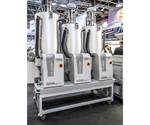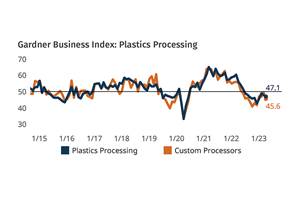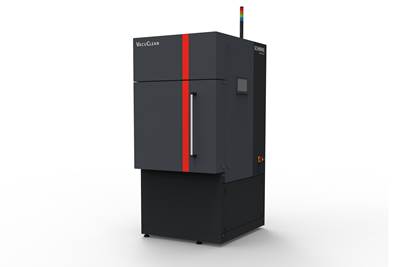K 2019 Report: Auxiliaries Stake Their Claim in the Circular Economy
The theme of sustainable plastics pervaded the exhibits at K 2019, even those of auxiliary equipment suppliers, where everything from dryers to blenders to hopper loaders was reimagined as part of a circular plastics process.
In auxiliary equipment at October’s K 2019 show, the green-ward shift was manifested in new machinery designed for drying, conveying, blending and feeding recycled materials. Carl Litherland, chief marketing officer at Motan, said his company, like many others in Düsseldorf, was responding to customer and market interest. “We handle raw materials, whether they’re virgin, regrind or recyclate,” Litherland said, noting that for the latter materials, mechanical and physical properties are different from those of virgin pellets. “It’s becoming more complicated; our product has to become more intelligent to recognize and deal with different materials.”
Material Handling/Conveying
Motan introduced the Metro G/F/R (granulate, flake, regrind) at K, saying the unit can automatically load large quantities of granulate, dusty regrind and flakes, utilizing filters and large outlet flaps for smooth operation. Motan says dust is actively removed and conveyed to a central dust filter. The filter itself is made from PTFE-coated cloth, and a compressed-air accumulator integrated into the loader’s lid has a direct connection to air outlet nozzles for filter cleaning.
A hinged lid, without vacuum and material hoses, allows the loaders to be easily cleaned during material changes. Metro G/F/R models use a large-diameter pneumatic butterfly valve for material discharge and to break up bridged material. A rotary paddle switch is installed below the valve to start the conveying cycle automatically when the material level drops below the sensor.
Motan’s new Metroflow gravimetric loader weighs every load it processes with precision of <1% guaranteed, thanks to a digital load cell, using control software to account for vibrations caused by the processing machine. Motan notes that since bulk densities can vary in recycled or reground materials, load weight accuracy becomes very important. Loaders come in 6-, 10-, and 30-liter capacities. The discharge flap’s damper is spring loaded to prevent it from closing completely when not under vacuum. During a conveying cycle, any material left on the flap that could get trapped is sucked away. As vacuum increases, the flap presses against the spring and closes completely. Further, a counterweight for the discharge flap mounted on the outside of the loader indicates the loading cycle’s status.

Motan’s Metroflow gravimetric loader utilizes proprietary software to account for vibrations.
Instead of pneumatically operated discharge, the Metroflow uses a magnetic flap. Normally, after each conveying cycle, vacuum used for conveying is released and the material’s weight would cause the discharge flap to open, but with the magnetic system, it remains closed. Only after the material in the loader has been weighed, is the holding magnet deactivated and the material is discharged.
Motan’s Metro HBS three-phase loader handles throughputs from 661 to 3527 lb/hr and comes with a separate three-phase floor-standing lower station, with an alarm to indicate insufficient material. Automatic implosive filter cleaning is standard, and the units are available with two material inlets. A separate mixing valve isn’t required, since the Metro HBS has an integral proportioning function for virgin and regrind material, allowing the ratio between the two streams to be adjusted. A single control can manage up to two loaders plus a blower.
Blending system supplier Plastrac introduced a patent-pending approach for continuous blending of color and other additives. ColorStream was conceived as a solution for a customer that wanted to eliminate employees climbing ladders or stairs to clean and change out additive hoppers located high above the plant floor and mounted on the sides of the main component loader. This new system separates additive metering from handling and feeding of the main resin component, locating it at floor level in a compact design for processors lacking space for a large floor-mounted blender along with the central loader/receiver for virgin material.

Plastrac’s ColorStream separates additive metering from handling and feeding of the main resin component, locating it at floor level.
With ColorStream, cleaning and color changes occur at floor level, while all the system’s components above floor level are self-cleaning. ColorStream comes in a compact cart, mounted on casters, and it can support up to four additive feeders arranged radially around a collecting funnel. This funnel discharges additives into a vertically mounted venturi that unloads downward into a transport hose. Unlike a conventional venturi, which requires high-pressure compressed air, ColorStream uses low-pressure air supplied by an electric regenerative blower on the cart. Plastrac says these blowers can operate continuously for more than five years, delivering clean air that whole time, since there are no contacting parts that require lubrication. The venturi and transport hose are small enough to deliver sufficient air velocity to keep pellets floating in the air stream even when using a small, energy-efficient blower.
At the upper end of the system, a baffle box mounts on the inlet flange of the processing machine. The box’s top flange can support the central loader/receiver and buffer hopper, which supply virgin material. A cyclone-type receiver inside the baffle box separates the additives from the transport air. A metal screen between the cyclone and the exhaust duct keeps stray pellets from escaping with exhaust air. Pellets do not clog the screen because its much larger open area reduces air velocity below what would be required to lift the granules. Since surfaces are cleared by transport air or by the impingement of pellets, color changes don’t require cleaning of the hose or baffle-box components.
Labotek (represented here by Romax) updated its conveying unit lineup, including systems for conveying flake that target recycled materials. The SVR-F features a 100-liter hopper and 600-700 lb/hr throughput, with a special design to handle flake. In addition, the new SVR-P is designed to convey powder, targeting rotomolders and pipe manufacturers, among others. Featuring a redesigned flat filter on top with vibration and air to clean it, the unit’s throughput ranges up to 4409 lb/hr.
Piovan (parent of Universal Dynamics) displayed its Vakupulse technology, a dense-phase conveying technology it says is suited for conveying delicate raw materials at low speeds and flow rates over short distances. The company also debuted its Handlink+ manual coupling station. Piovan says the design makes it easy to connect pipes, even with only one hand. Gasket-free to prevent contamination, pellets come in contact only with stainless steel. The RFID tagging system ensures a match between material source and destinations. If there is a mismatch, the conveying system will not activate the loading cycle.
Piovan’s FDM business, which targets extrusion, showcased the new GDS 5 gravimetric blender. Designed to mount up to five pellet stations, the company says the GDS 5 maintains compact dimensions and features a Siemens PLC controller.
Targeting medical production, Piovan also introduced a microdosing unit, capable of feeding machines with a single granule at a time. Targeting cleanrooms, Piovan displayed the Pureflo filterless receiver, which reportedly requires neither compressed air nor maintenance, and the emission-free DPA dryer.
Maguire extended its 100% Injection Coloring technology as an option for its MGF gravimetric feeders. The technology allows the feeders to meter in color during the recovery and injection phases of the screw. Maguire notes that in an injection molding cycle, roughly 75% of resin enters the screw during the recovery phase and 25% during injection. Since conventional feeders add color only during recovery, insufficient mixing can occur. Maguire’s 100% Injection Coloring technology can eliminate typical answers to insufficiently mixed compounds, such as use of an upstream premixer or over-coloring.

Maguire’s 100% Coloring technology allows feeders to meter in color during the recovery and injection phases of the screw.
Schenck rounded out its Proflex family with lower feed rates for smaller masterbatch applications. The C100 joins the C500, C3000 and C6000. Smallest of the group, it’s a fit for smaller extruders. Up to five feeders can be grouped around an inlet of an extruder, and a quick-change hopper option allows for fast changeovers without disassembling the feed screw. The asymmetric design prevents bridging and plugging of sticky materials, and the integrated gearbox allows turndown ratios of up to 1:120. Schenck says a flexible wall allows constant and accurate filling of the feed screw.
Schenck also added to the Simplex line, which it launched at K 2016. The new Simplex FB 650, which joins the Simplex FB 1500, targets feeding of plastic flakes, cellulose, hemp, glass or carbon fibers, and other virgin or recycled materials for plastic film or compounding. Featuring a high-capacity, stainless-steel feeder designed specifically for handling light and fluffy materials, the Simplex FG 650 uses a bottom-driven vertical agitator, as well as an auxiliary agitator, to process hard-to-feed materials, including chopped PP or PET film.
Movacolor of the Netherlands, distributed in North America by Hamilton Plastic Systems, Romax and others, introduced three new gravimetric feeding and blending systems at K 2019. The MCHigh Output 2500R high-capacity dosing unit is for low-bulk-density regrind such as bottle flake. The MCTwin system is designed for reprocessing colored regrind from of injection molding sprues and rejects. And the MCContinuous Blender is aimed at wire and cable extrusion (see November Keeping Up).
Process Control introduced the WXOmega, developed in Germany and tailor-made for blending powder. Described as highly precise and energy efficient, the WXOmega powder batch dosing system can run up to six different powders. With dust-tight construction, each of the six powder hoppers has an integrated powder screw and bridge-breaking unit. The redesigned conical weight hopper has a butterfly valve and special load cell for improved accuracy. In addition, the powder agitator in the mixing chamber helps homogenize material blends. Throughput ranges up to 551 lb/hr, and Process Control says all parts in contact with ingredients are of stainless steel. The touchscreen control comes with a 7- or 10-in. display.
Italy’s Plastic Systems, which now has a U.S. headquarters in Atlanta, introduced a gravimetric blender for up to eight components, as well as new receivers for a central conveying system. These feature PLC controls that can be monitored or controlled remotely via smartphone or tablet. In addition, there was a new automatic manifold distribution system, with an optional weighing system that calculates resin usage, and the Easy Way 4.0 supervisory system, which collects and stores operating data for all injection machines and auxiliaries in a plant.
Resin Drying
Piovan debuted its GenesysNext drying system that the company says features “self-adaptive technology” optimized for recycled PET. Process air flow, dewpoint, residence time, temperature and more are automatically managed as hourly production and initial temperature and humidity of the plastic granulate vary. The original Genesys line launched in 2010.
Piovan says improvements have also been made to the AIPC (Automatic Injection Pressure Control) technology, which it claims ensures the lowest production cost for PET preforms. Piovan says the new control, which features predictive maintenance, connects the dryer with the injection molding machine. Measuring injection pressure via transducer every 5 millisec, the dryer can reportedly avoid overdrying PET. A new patented filtration system can absorb VOCs. The system signals an alert to change the filter when necessary.
The company also launched preform inspection products at K 2019. InspectAC allows molders to check a preform’s acetaldehyde levels nondestructively. Instead of sending preforms to a lab, molders can check levels beside the press in 30 min. In addition, the InspectBE technology measures benzene, which can result from the PET recycling process. This unit measures benzene in parts per billion, inline, in 35 min. All of this can be connected via Piovan’s winfactory platform.
Wittmann Battenfeld’s new Aton H1000 battery dryer can handle a dry-air volume of 1000 m³/hr, for a drying throughput of 1102 lb to 1322 lb/hr. This marks the first extension of its Aton segmented-wheel dryers from beside-the-press to central drying duty. The company says the system can reach a -85 F dewpoint. Tied into the company’s Wittmann 4.0 platform, the Aton H1000 features a larger, 5.7-in touchscreen. The existing Aton line provides dry-air volumes from 30 to 120 m³/hr.

Wittmann Battenfeld’s Aton H1000 battery dryer extends this segmented-wheel line from beside-the-press to central drying.
Options for the Aton H1000 include dewpoint-controlled drying, with LED lights to indicate dryer status. Variable-frequency drive is also available.
ProTec’s Somos RDF modular resin drying system, which consists of units with their own dry-air supply and controllers, also debuted at K. The individual operating units can be combined into an overall system with central visualization and control. The dryers are available with capacities from 50 to 400 liters and drying temperatures of 140 to 284 F; high-temperature models up to 356 F are available.
Maguire used K to rebrand its line of vacuum dryers with a new name—Ultra. These low-energy dryers are based on technology introduced by Maguire in 2013 under the name VBD. Since that time, Maguire says the actual energy savings achieved with its vacuum technology is greater than originally claimed (see September’s K 2019 Preview).

Maguire’s vacuum-drying technology was rebranded at K as Ultra.
Plastic Systems introduced a modular system of one to 10 honeycomb-rotor desiccant dryers, each with its own hopper. A single PLC control system allows for drying different resins simultaneously via independent, self-adaptive control for each hopper based on material level and drying-air temperature, dewpoint and airflow.
Process Heating & Cooling
HB-Therm of Switzerland debuted the Thermo-5 water temperature-control units (TCUs), featuring variable-speed radial pumps; temperature limits of 212, 284 and 320 F; heating capacity up to 32 kW; and cooling capacity up to 110 kW. The company noted the unit’s compact size, with a height of 650 mm (not quite 25 in.), which allows it to be stored below most modern injection machines.

HB Therm’s Thermo-5 TCUs feature a lifetime warranty for the heating unit.
The TCU’s Eco-pump variable-speed stainless-steel radial pumps work at a power of 2.2 kW and circulate a maximum of 220 l/min. In Eco mode, the unit can regulate the in/out temperature difference (ΔT), as well as flow rate or pump pressure, with all energy savings indicated and logged. Temperature control is said to be ±0.1° C with self-optimizing regulation. A tankless system with indirect cooling provides short heating and cooling times, since only the minimum necessary amount of heat-transfer fluid is used. The minimum circulation volume also requires less power. Mold-specific parameters can be saved and integrated into the the molding machine’s control.
The units feature automatic process monitoring, including ultrasonic flow measurement; hose rupture and leakage detection; a hydraulic circuit of corrosion-resistant materials; and a lifetime warranty for the heating unit. Heating elements have no direct contact with the fluid medium. Seal-less pumps further reduce maintenance. The closed system has no oxygen contact and utilizes active pressure regulation to protect molds.
An optional OPC-UA interface “future-proofs” the units for Industry 4.0, according to HB-Therm. The TCUs can be remotely controlled, and through OPC-UA, they can share data with other machines, controllers, or QA and MES systems. An optional cleanroom package for Thermo-5 features fiber-free insulation, abrasion-resistant PUR rollers and a high-gloss finish.
Mouldpro APS of Denmark introduced its digital flosense 4.0 cooling manifold at K. Distributed by Alba in the U.S., the flosense 4.0 can connect up to four manifolds, and its touchscreen can monitor up to 48 separate cooling circuits. As a replacement for analog manual flow regulators, Mouldpro says a digital flow manifold allows a higher flow capacity and temperature range, as well as data storage and export. Featuring an OPC-UA interface, the control’s main screen shows all circuits, including data on flow and temperature, as well as pressure at the main inlet and outlet. By clicking on a specific circuit, users get more detailed information, including ΔT of that channel. A turbulent-flow indicator is included, and the system has an audit log to track all events. Data are stored in the internal memory and can be displayed graphically for each circuit, as well as exported for external use.
Single’s new Easitemp 95 TCU features a compact, corrosion-resistant design and reportedly can handle continuous duty with low contamination sensitivity and consistent performance even under heavy loads. With 6 kW heating capacity for continuous duty up to 203 F, the Easitemp has 45 kW cooling capacity at 176 F inlet temperature and 59 F coolant temperature. The immersion pump is rated for 40 l/min and 3.8 bar, and reverse-polarity connectors provide a leak-stop mode and tool unloading with particle filter.

S.i.S.E added color touch screens to its TCUs.
S.i.S.E. of France introduced color touchscreens on its oil and water TCUs. Also new is a range of pressurized-water TCUs (6 to 60 kW) for temperatures of 284 to 356 F and outputs from 60 to 200 l/min.
Wittmann Battenfeld expanded its Tempro line of temperature controllers at K with a pressurized unit capable of reaching a maximum temperature of 212 F (see September Keeping Up). The new Tempro plus D100 is capable of 9 kW heat output and uses a magnet-coupled, stainless-steel pump to ensure sufficient flow. Pump capacity is 0.5 kW, with a maximum flow rate of 40 l/min (10.5 gpm) and a maximum pressure of 4.5 bar (65 psi).
Engel showed two enhancements of its program to digitalize mold-temperature control. One is a new e-temp XL model, a larger version of its TCU with variable-speed pump built for Engel by HB-Therm. The other is a new e-flomo feature: automated, sequential air-purging (blowing out) of the manifold circuits in the injection mold when changing molds or mold inserts (see November Keeping Up).
Related Content
Plastics Processing Business Index Contracts Further
All components dip as index hits low point of 2023.
Read MoreProcessing Takes a Dip in June
Plastics activity took a relatively big downturn in June, ending at a low for the year and lower than the same month a year ago.
Read MoreProcessing Megatrends Drive New Product Developments at NPE2024
It’s all about sustainability and the circular economy, and it will be on display in Orlando across all the major processes. But there will be plenty to see in automation, AI and machine learning as well.
Read MorePlastics Processing Continued Contraction in April
Despite some index components accelerating and others leveling off, April spelled contraction for overall plastics processing activity.
Read MoreRead Next
‘Circular Economy’ Will Be Unifying Theme at K 2019 Show
Even injection machine suppliers like Engel will talk about ways their technology can support recycling.
Read MoreK 2019 Preview: Auxiliaries Showcase Connectivity & Efficiency
At press time, a handful of auxiliary suppliers shared some of their K 2019 plans, highlighting connectivity and efficiency in their planned displays.
Read MoreMaterials Handling: Drying, Blending, Conveying News at K 2019
Plastic Systems arrives in the U.S. with a handful of new auxiliaries.
Read More






























